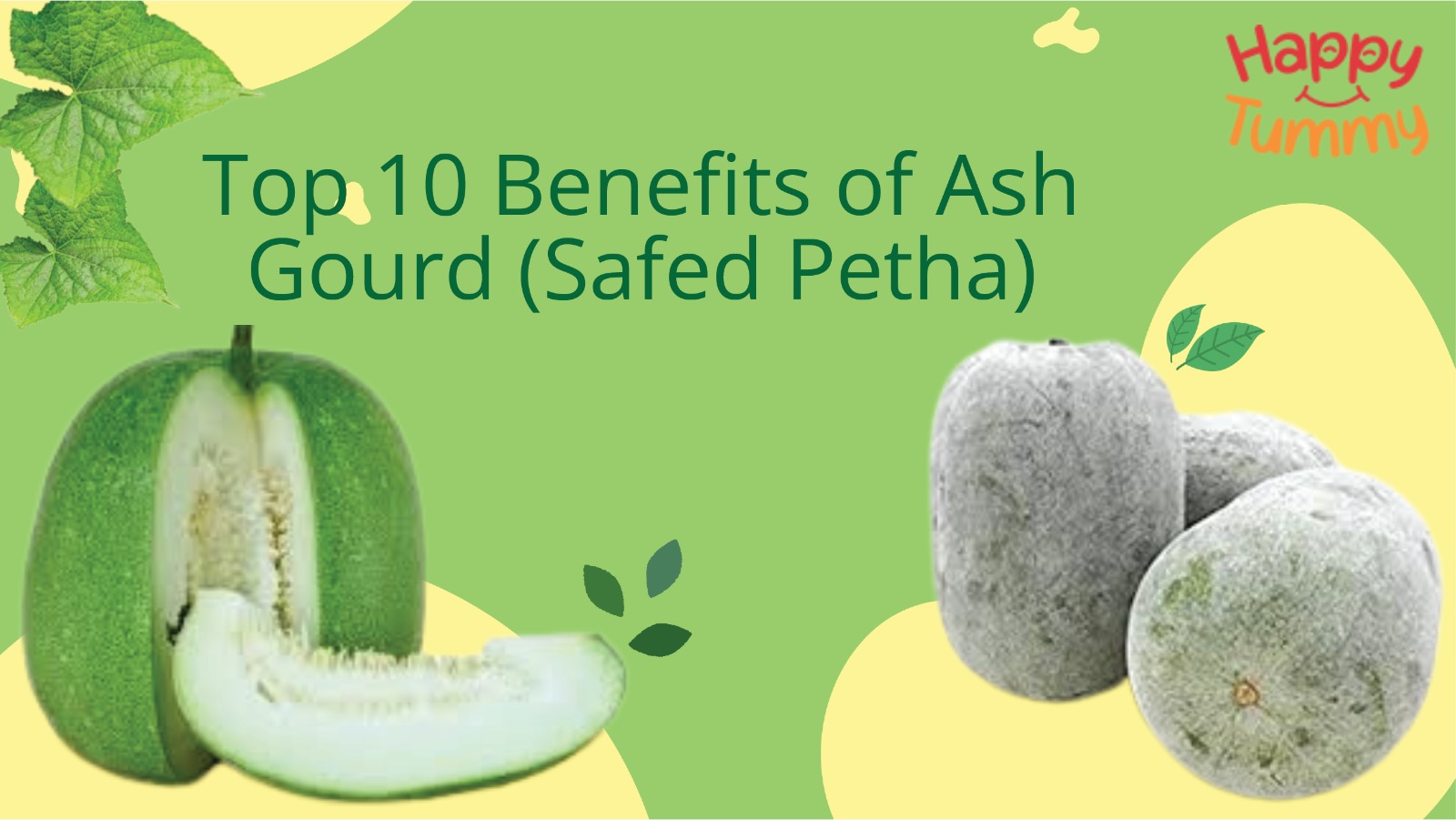Table of Contents
If gourds are not your favourite, you fall in a pool of people who often eat these vegetables when sick and want to eat something light.
One of them is ash gourd, often referred to as safed petha, white pumpkin, or winter melon. It is a versatile vegetable valued for its low calories and vital nutrients.
For generations, traditional medical systems have prized this healthy vegetable for its ability to support holistic wellness.
This article will discuss the various health advantages of ash gourd and how eating it may help you add an excellent product in your diet!
What is Ash Gourd?
Safed petha is an oval-shaped creeper fruit with yellow flowers. It has a thick white skin while it is still immature and tastes sweet.
This vegetable has been in use for many years in our Indian kitchens for a very long time, and even Ayurveda has recognized it for its medicinal properties and referred to its preparation as “kushmanda.”
The entire vegetable, including its seeds and leaves, is considered good for health.
Different Names of Ash Gourd
Ash gourd is scientifically known as Benincasa hispida, and in India, this vegetable is popular and has different names.
In Hindi, we call it safed petha; in Telgu, it is Boodida Gummadi; in Tamil, it is called Neer Pooshnikkai; and in Malayalam, it is Kumbalam.
Nutritional Profile of Ash Gourd
Let us look at the nutritional profile of this fantastic vegetable in 100 grams [1]:
| Protein | 0.79 g |
| Fat | 0.12 g |
| Dietary Fibre | 3.37 g |
| Carbohydrates | 2.84 g |
| Energy | 17.44 kcal |
| Calcium | 19.39 mg |
| Iron | 0.47 mg |
| Magnesium | 19.95 mg |
| Potassium | 372 mg |
Health Benefits of Ash Gourd

Safed petha is highly nutritious for health and has many benefits to offer. Let’s look at some of them below:
#1. Digestive Health
Digestion is becoming a common issue these days. If you are also facing this problem, you may want to add ash gourd juice to your diet.
If taken on an empty stomach, the ash gourd juice may help promote healthy bowel movements. The juice may also help clean your gut and kick-start an easy digestion process.
Moreover, its fibre content may also support the overall digestion system [2].
If you want to know more about your digestive health, take a quick 2-minute Digestive Quotient Test by Aashirvaad Atta.
#2. Skin and Hair Health
Ash gourds’ juice and roots may be good for your skin health.[3]
Its juice may give your skin and hair a healthy glow. People use fruit extract of this vegetable to make face masks that may help prevent spots and pigmentation. It may also help relieve burning sensations.
You can make ash gourd and honey face masks at home for shiny and glowing skin. Simply grate some safed petha and mix it with honey. Apply this paste to your face and neck. Leave it for 15-20 minutes.
Wash it off with lukewarm water.
Also, the juice may help in healing scalp and hair issues, such as roughness and dandruff [4]
#3. Heart Health
Safed petha may be great for your heart health as it has zero cholesterol. Moreover, this vegetable has two essential antioxidants –carotenoids and flavonoids, which may prevent build ups on artery wall [5] [6].
#4. Immunity and Metabolism
Ash gourd is an excellent source of vitamin C, carotenes, and flavonoids that may help promote a robust immune system.
Eating this vegetable may give blood cells vitamin C, which is then transferred to other organs to restore their optimal operating levels since sickness lowers organ performance.
Besides, it has many curative properties that may help in conditions such as jaundice, fever, and diabetes. Thus, helping build strong immunity.
It also has many anti-inflammatory and antioxidants that may help enhance the immune system [7].
#5. Diabetes
This vegetable may be great for people with diabetes. It may help maintain the sugar levels in the body as it does not spike the blood sugar levels [8].
Moreover, it is also low in calories, which may be an added advantage for diabetic people. Its juice is often used in traditional medicines because of its anti-diabetic effects.
You can eat ash gourd’s sabzi with rotis made of Aashirvaad Sugar Release Control Atta for better nutrition and sugar control.
#6. Weight Management
The juice made may be suitable for weight management. It is high in fibre and low in calories, making it an ideal choice for people looking for weight loss.
The dietary fibre present in this vegetable may keep you full for a long. Thus, it may reduce cravings and may also assist in burning fat quickly [9].
If you wish to check the fibre content in this vegetable or its juice, you can find it on My Meal Plan by Aashirvaad Atta.
#7. Detoxification
This vegetable may also be great for the detoxification process in the body. If consumed on an empty stomach, it may help remove waste products and toxins [10].
#8. Cooling Effect
This vegetable is very similar to cucumbers and contains a lot of water. Therefore, people prefer to drink its juice for a cooling effect, especially during summer [11].
The high water content in this vegetable may help regulate body temperature and prevent from heat strokes.
#9. Mental Health
The seeds of this vegetable contain L-tryptophan. It is an essential amino acid that our body cannot produce alone.
Its deficiency may lead to people experiencing mental health issues. This L- tryptophan is found in the seeds of this unique vegetable.
Cooked ash gourd may help reduce depression and promote well-being and happiness [12].
How to Include Safed Petha in Your Diet?
Here are some delicious ways of including this tasty and nutritious vegetable in your family’s diet:
- Sabzi – Make a safed petha ki sabzi (recipe shared below).
- Curry – This can be an excellent pair for your rice and dosas.
- Dal – You can add safed petha to your dal to make it more nutritious.
- Sweets – Many sweets, such as Agra ka petha, can be made using this vegetable.
- Stews – Stews are similar to soup and very healthy when added to vegetables.
- Salads – Since you can add ash gourd raw, you can add it to salads.
Ash Gourd Juice Recipe
Ingredients:
- Ash gourd – 1 small
- Fresh lemon juice – 1-2 tablespoons
- Mint leaves –for garnish
- Sugar or honey – as per taste
Method:
- Peel the safed petha and cut it into small cubes by removing its seeds.
- Put the cubes in a blender and blend until it’s smooth.
- Using a strainer, strain the mixture and extract the juice. You can discard the pulp.
- Now, you can add lemon juice and even sugar as per taste.
- For better taste, refrigerate the same for a couple of hours before serving.
- Garnish with mint leaves and serve.
Ash Gourd Sabzi Recipe
Ingredients:
- Ash gourd – 200 grams
- Onions – ½ cup chopped
- Green chilli – 1 chopped
- Mustard seeds – ½ teaspoon
- Cumin seeds – ½ teaspoon
- Turmeric powder – ½ teaspoon
- Curry leaves – 12 – 15
- Coconut – ½ cup grated
- Coconut oil – 1 – 1.5 tablespoons
- Salt – as per taste
Method:
- Wash, peel and chop the ash gourd.
- Heat coconut oil, add mustard seeds and let them pop.
- Add cumin seeds, and when they sizzle, add onions and sauté till transparent.
- Mix in green chilli and curry leaves.
- Add safed petha to this.
- Mix in turmeric and saute for a minute.
- Cover the pan and let it cook. Remember not to add water as safed petha has much water in it.
- Cook for at least 7-8 minutes or till it is done.
- Mix in the grated coconut.
- Add salt and cook for a couple of more minutes.
- Serve it with a side of your choice.
When is the Best Time to Drink Safed Petha Juice?
People should consume this juice on an empty stomach in the morning. When consumed in this way, it may help with better results.
This juice can be consumed the entire year, even during winter.
How to Store Ash Gourd Juice?
It is always preferred to have the juice fresh. You should consume it within 15 minutes of preparing it. However, you can also refrigerate it and have it chilled.
You can keep it in an air-tight container and consume it within the same day.
Side Effects/ Precautions with Ash Gourd
Although this vegetable is excellent for overall health and wellness, you must always consult your dietician or doctor before introducing anything new to your diet.
Anti-nutritional elements found in these gourds, such as phytates and oxalate, may hinder the body’s capacity to absorb nutrients.
Ash gourd juice consumption may also increase the risk of calcium deposition, which can result in kidney stones.
You can also speak with one of our dieticians and discuss how to incorporate this versatile ingredient into your diet.
Final Thoughts
To sum up, ash gourd is a unique vegetable that offers a wide range of health advantages. It has several benefits for anyone looking to improve their health organically, from helping with digestion and weight reduction to strengthening immunity and improving general well-being.
You may use this vegetable’s ability to promote a more lively and healthy existence by including it in your diet. Eat raw, boiled, or in a juice, ash gourd is still a great addition to the kitchen of any health-conscious person.
FAQs
Although there is no harm in eating this vegetable every day, it is advised to eat it in moderation. Moreover, speaking with your dietician or doctor about the amount of food you should eat daily will be good.
These gourds include anti-nutritional substances, including oxalate and phytates, which may impair the body’s ability to absorb nutrients. Drinking too much ash gourd juice may also raise your chance of developing kidney stones due to calcium deposition.
These gourds are said to possess antioxidant and anti-inflammatory qualities. These qualities may benefit the liver, which is involved in many metabolic functions and the body’s detoxification of toxic chemicals.
Since this gourd is mainly made of water, it is cold and helps cool the body.
Yes, you can eat it raw by just peeling its skin. You can add it to your salads if you want to eat it raw.
















